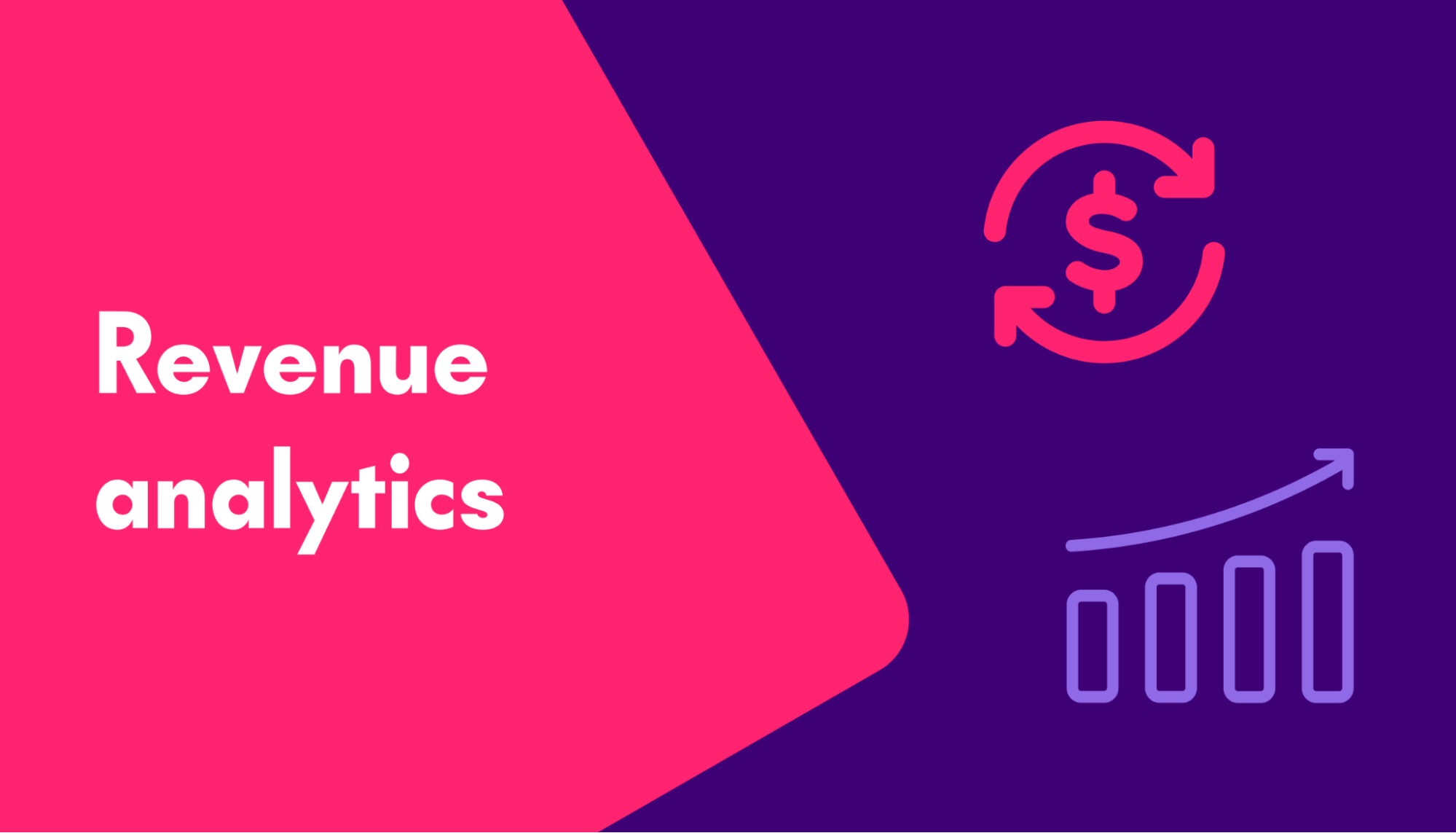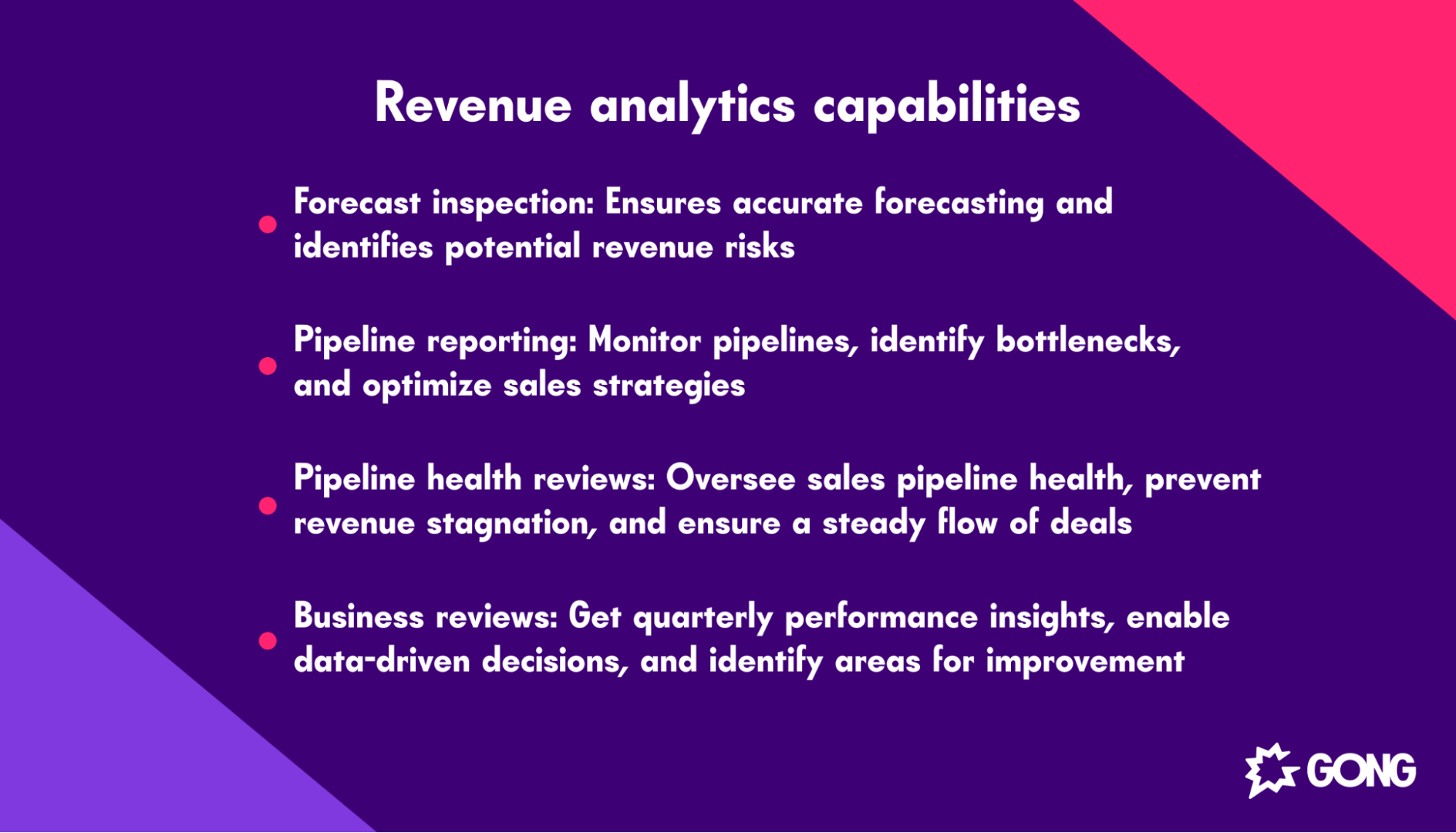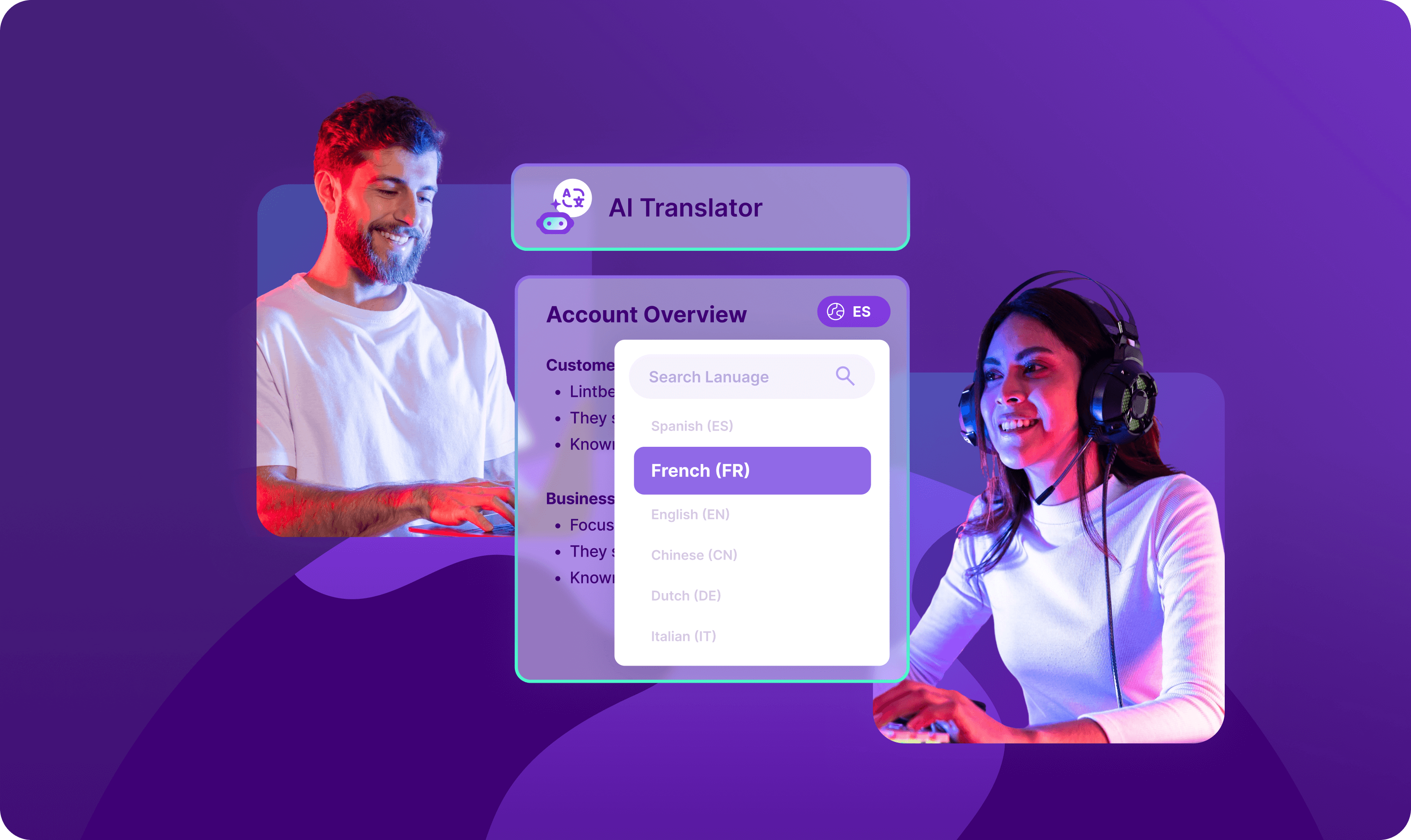Sales strategies
Unlocking growth: A guide to revenue analytics

Michael Rosenson
Sr. Manager, Strategy & GTM BizOps
Published on: May 22, 2025

Managing revenue can be volatile. One month, you’re on track, the next month, you’re scrambling to determine what’s throwing off your forecasts. Customers are churning unexpectedly, team performance is inconsistent, and opportunities are vanishing before you even know about them.
This sad state of affairs isn’t due to a lack of effort. It’s due to a lack of insight.
The solution to this insight problem is revenue analytics. It can highlight gaps and opportunities, making it easier for sales leaders to set and achieve their targets.
This guide will explain revenue analytics, how it works, and some advanced strategies you can use to drive growth.
What is revenue analytics?
Put simply, revenue analytics turns raw data into actionable insights that drive revenue growth and business efficiency.
It uses a strategic approach to analyzing and interpreting revenue data to identify trends, forecast growth, and optimize performance.
It goes beyond data collection and basic financial reporting, looking deeper into your numbers to reveal trends.
Used properly, it can also help you improve your forecast accuracy and sales performance, and inform strategic planning initiatives .
For example, a subscription-based software company might use revenue analytics to prevent customer churn. By digging into their data, they can pinpoint less engaged customers who are at risk of canceling. Using that insight, they can make targeted efforts to re-engage those customers before it’s too late.
How it works
It starts with historical sales data, things like current customer relationship data, rep performance data, and sales pipeline data. Revenue analytics software then analyzes the relevant data to paint a complete picture of your pipeline. With the assistance of AI and machine learning, revenue analytics solutions can more accurately spot trends, forecast future revenue, segment customers, and identify stalled or at-risk deals — and the best ones do it in real time.
These insights are presented in unified dashboards and reports, making it easier for finance, sales, revenue operations, product and marketing teams to take action.
Which key metrics should you track?
Revenue analytics platforms are powerful enough to analyze all kinds of data. However, you’ll want to be focused with the data you’re analyzing. Here are some key metrics to track as you’re getting started:
- Monthly recurring revenue (MRR) and/or annual recurring revenue (ARR): These two metrics demonstrate how predictable your income is. They’re critical for subscription-based models. MRR tracks short-term growth trends, while ARR gives you a longer-term view of your business.
- Customer lifetime value (CLV): CLV measures a customer’s total spend on your offering throughout your relationship. This metric helps prioritize which customers are high-value so you can strategize on how to keep them.
- Churn rate: Churn rate indicates the percentage of customers who cancel over a specific period. It’s vital for understanding customer satisfaction and preventing revenue loss. Even small swings in churn can have significant impacts on your profit.
- Revenue by customer segment: Segmenting revenue by customer groups reveals which segments are valuable — and which ones are less so. This insight helps refine marketing and sales for maximum ROI.
- Net revenue retention (NRR) and gross revenue retention (GRR):. GRR focuses solely on retaining existing revenue, while NRR accounts for expansions, contractions, and churn. Together, they give you a comprehensive view of customer revenue.
- Expansion revenue: This data point includes revenue from upsells and cross-sells. It highlights growth within your existing customer base.
- CAC-to-CLV ratio: The CAC-to-CLV metric explores the connection between customer acquisition cost (CAC) and CLV to determine the effectiveness of acquisition strategies.
What are the benefits of revenue analytics?
Revenue analytics transforms raw data into actionable insights. That gives you and your team several valuable benefits:
Prevents revenue leakage
With revenue analytics, teams can instantly clarify the status of every deal in their pipeline. Analytics factor in real-time pipeline data, buyer signals, and predictive models to show sales leaders and reps which deals are most likely to close and which ones need attention. That gives you time to identify and correct problems before they impact your bottom line.

Provides customer insights
Analytic solutions can also show you high-value opportunities. They highlight priority customers and uncover upselling and cross-selling possibilities.
For example, you can segment customers based on profitability. Then, your company could target its most valuable segments with proactive retention strategies.
These insights help businesses personalize their outreach for increased customer satisfaction and loyalty.
Enables data-driven forecasting
Revenue analytics solutions help you avoid surprises. Gong’s Revenue AI Platform , for example, delivers highly accurate forecasts backed by actual data.
Analyzing the current state of your pipeline alongside historical sales data using revenue analytics gives you more realistic sales estimates.
With precise forecasts, you can better understand pacing to sales targets, allocate resources effectively, and make informed strategic decisions — all while minimizing guesswork and increasing predictability.
Supports cross-functional decision-making
The ability to corral your data also gives your company’s sales, finance, and marketing teams a unified view of revenue. This visibility eliminates data silos . Your team can then work faster with more cohesive decision-making.
That means deeper alignment and streamlined workflows . Marketing can refine their campaigns, sales can personalize their approach, and finance knows exactly what to expect.
How to implement revenue analytics
Now that you understand why revenue analytics are important, let’s look at how you’ll start using them:
Centralize data
With the right revenue analytics solution, you’ll be able to bring all your data into one place and create a single source of truth.
Pull CRM, ERP, and other system data into a unified platform. Make sure these systems are synced in real time to provide ongoing insights, and that your data is as clean, complete, and standardized as possible.

After your data is centralized, build specific dashboards for various roles and teams so they can always access relevant insights easily.
Define key metrics
Next, determine the top metrics you want to focus on. Select enough of them to gain insights but not so many that you overcomplicate your process.
Combine lagging metrics with leading indicators to balance historical data with future predictions. Establish a hierarchy to clarify which KPIs drive decisions and which serve as supporting data.
Your chosen metrics can change over time. Host annual cross-functional workshops to reassess your metrics strategy.
Implement intelligent analytics tools
Adopt a revenue AI platform to leverage automation and streamline your efforts. These solutions have customizable, real-time dashboards that help you visualize essential insights.
You’ll be able to save time, reduce errors, and unlock your understanding of every deal.
Run predictive analytics models
Combine your internal data with external market info — such as competitor data and market trends — for more holistic forecasts.
Use scenario modeling to gauge the potential impact of market changes and economic conditions .
Ensure complete, unbiased data
Good data is the foundation of this approach. Some platforms can flag anomalies in real time, but you should still also appoint individuals to oversee your data quality.
Add confidence scores to different data categories so teams can prioritize the most reliable data.
Get actionable reports
Actionable insights are your goal, but you need a good platform that’s capable of creating them.
The best revenue analytics solutions use graphics and visual indicators to highlight the most urgent data and recommended next steps.
Integrate this information into your daily workflows so that team members can easily digest and collaborate on the insights you’re generating.
Overcoming critical challenges with revenue analytics
It’s vital that you understand common errors and challenges in advance. Here are some of the most important ones to watch for:
Chasing incomplete data
Relying on what your reps recall from client meetings is ineffective. It leads to biased, incomplete, and sometimes inaccurate data. You’ll miss valuable insights if this is your only source of information.
A revenue AI platform automatically captures and analyzes all your team’s customer interactions to give you an accurate view of your pipeline.
Remember: Clean data is important, but perfection isn’t necessary. Set thresholds for acceptable data accuracy, and keep your processes moving.
Misinterpreting churn
It’s easy to mistake quiet customers for churn risks . Misclassifying them as churn leads to wasted retention efforts. It also misses opportunities to nurture loyal but low-engagement customers in the ways they desire.
Pinpoint these quiet loyalists to better understand and decipher their needs from those of legitimate flight risks.
False positives in forecasting
Predictive models sometimes get it wrong. Make sure your team doesn’t overreact to an incorrect call and waste resources.
Test the accuracy of your forecasts and focus on high-certainty insights. Prioritize forecasts with multiple data points or team inputs.
What does forecasting look like today? I don’t see it as a leadership exercise or something that just falls on the shoulders of sales leadership. It really takes the team to get forecasting.”
– Diego Panama, Former Chief Commercial Officer, LiveRamp
Elevate your revenue analytics with Gong
Now you know how revenue analytics can help you corral and assess your organization’s customer, market, pipeline data to drive greater revenue.
If you want to learn more about how to use modern analytics software to improve your revenue team’s overall performance, check out these articles:
- Revenue intelligence for marketing: Try these 4 workflows
- 5 Ways to unlock your sales team’s productivity using revenue intelligence
- Guide to sales intelligence tools: Important features, selection criteria, and more
Book a demo with one of our experts today to learn more about the revenue analytics available on Gong’s Revenue AI Platform!

Sr. Manager, Strategy & GTM BizOps
Michael Rosenson is a Sr Manager of Strategy & Insights at Gong. Michael leads global pipeline target setting and performance management & is a key partner in the development of Gong’s Revenue Analytics platform.
When he’s not digging for insights gold, Michael enjoys practicing his dad jokes on his two kids (who find him very funny).
Discover more from Gong
Check out the latest product information, executive insights, and selling tips and tricks, all on the Gong blog.



